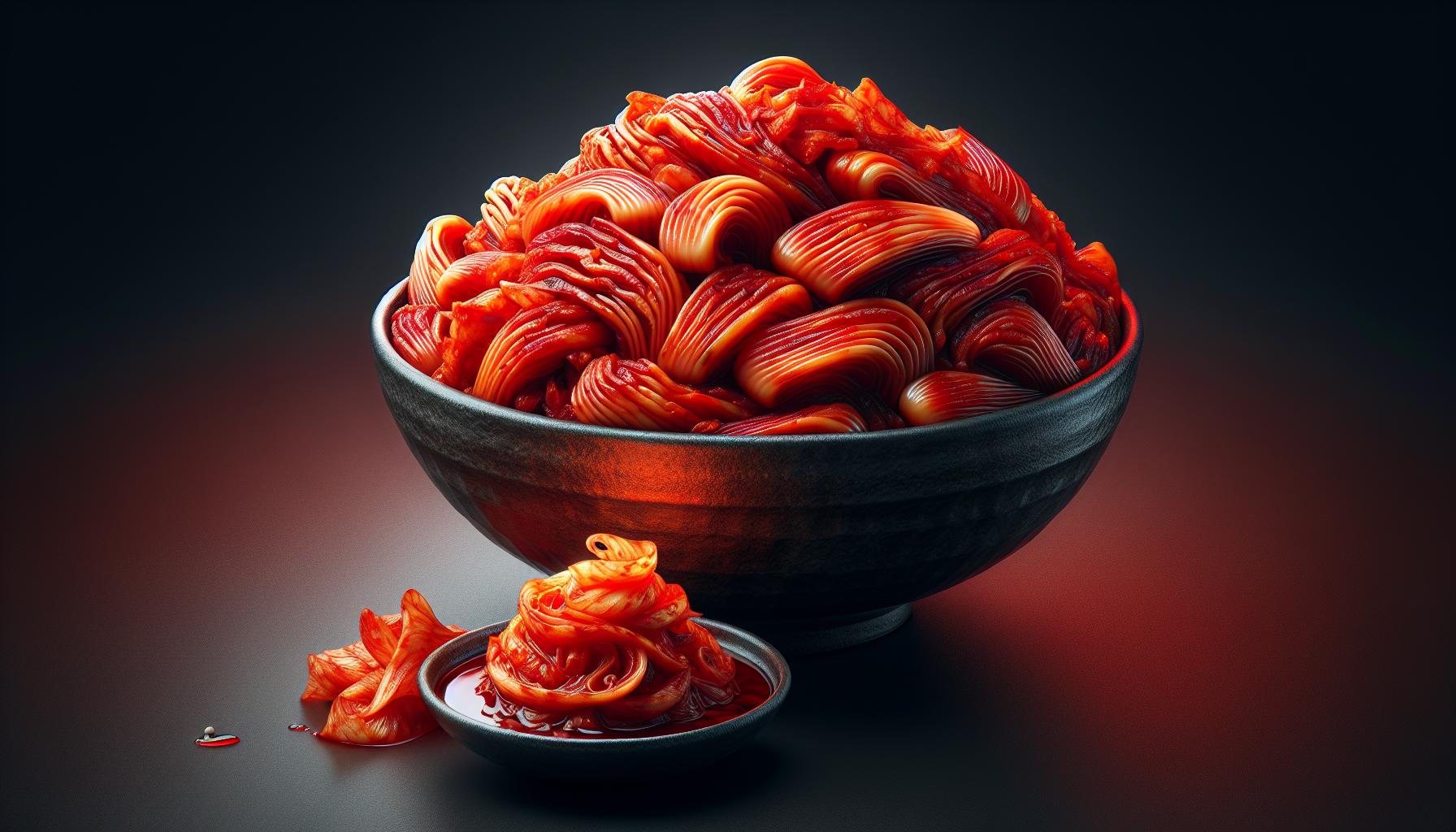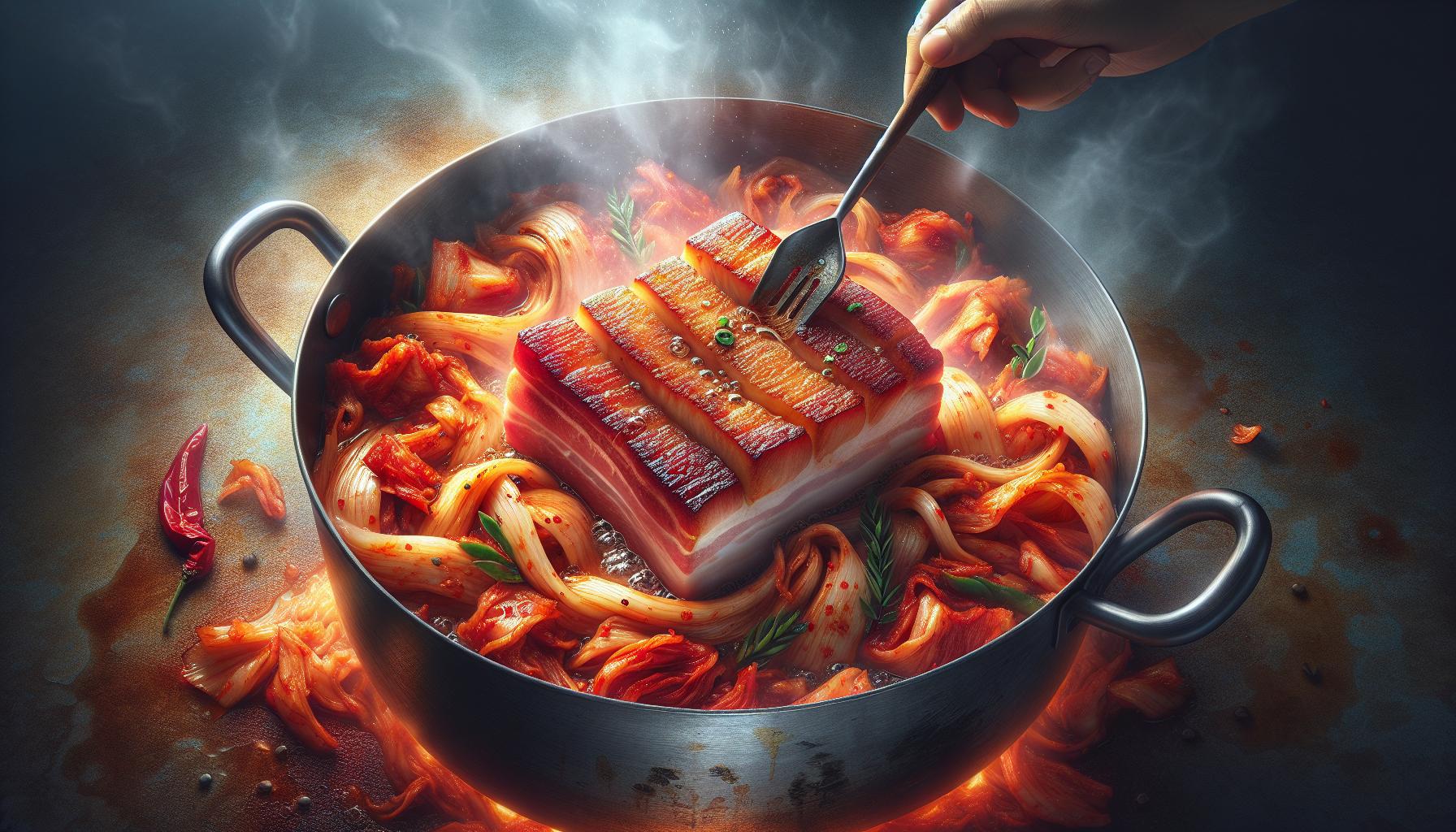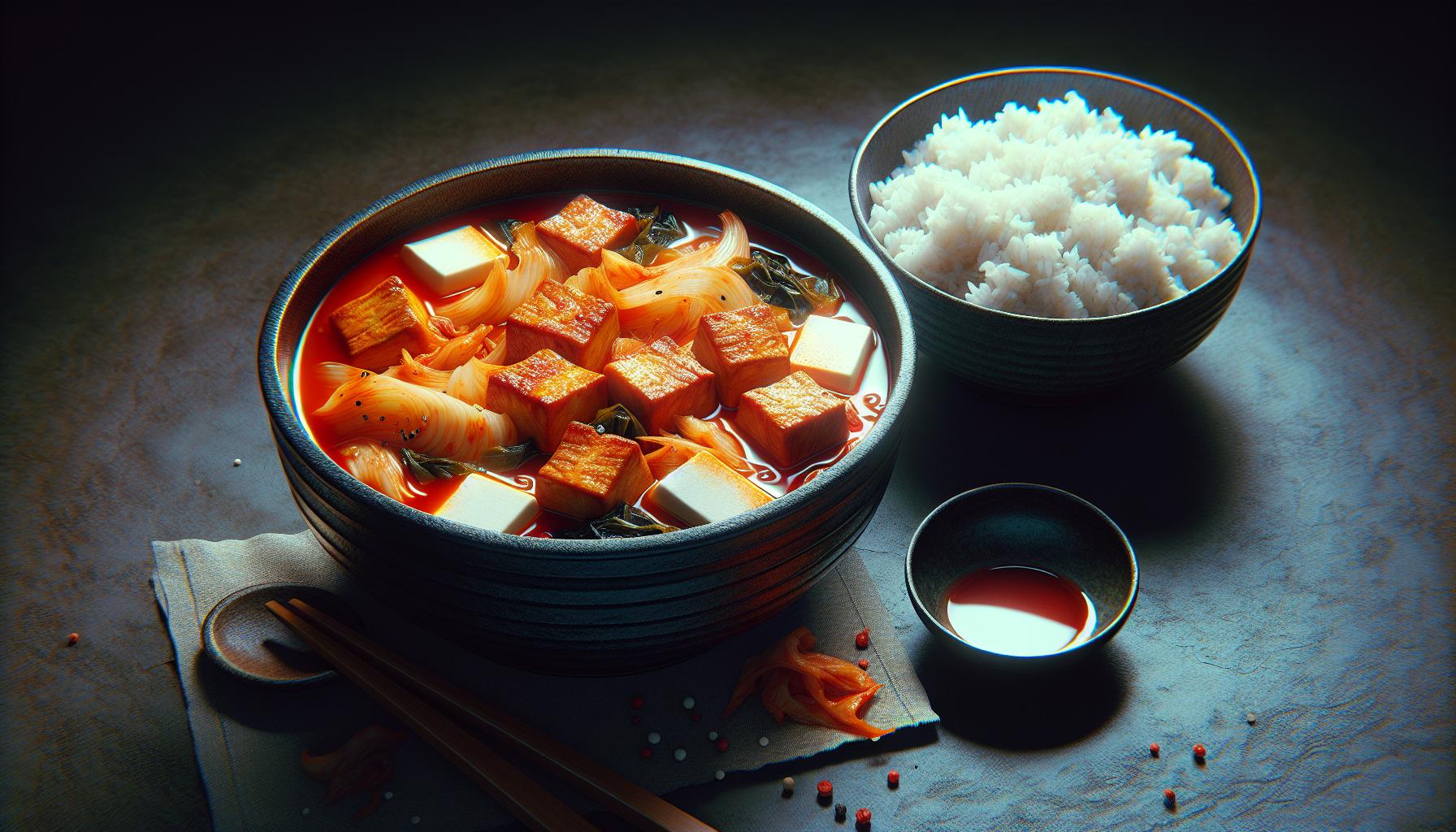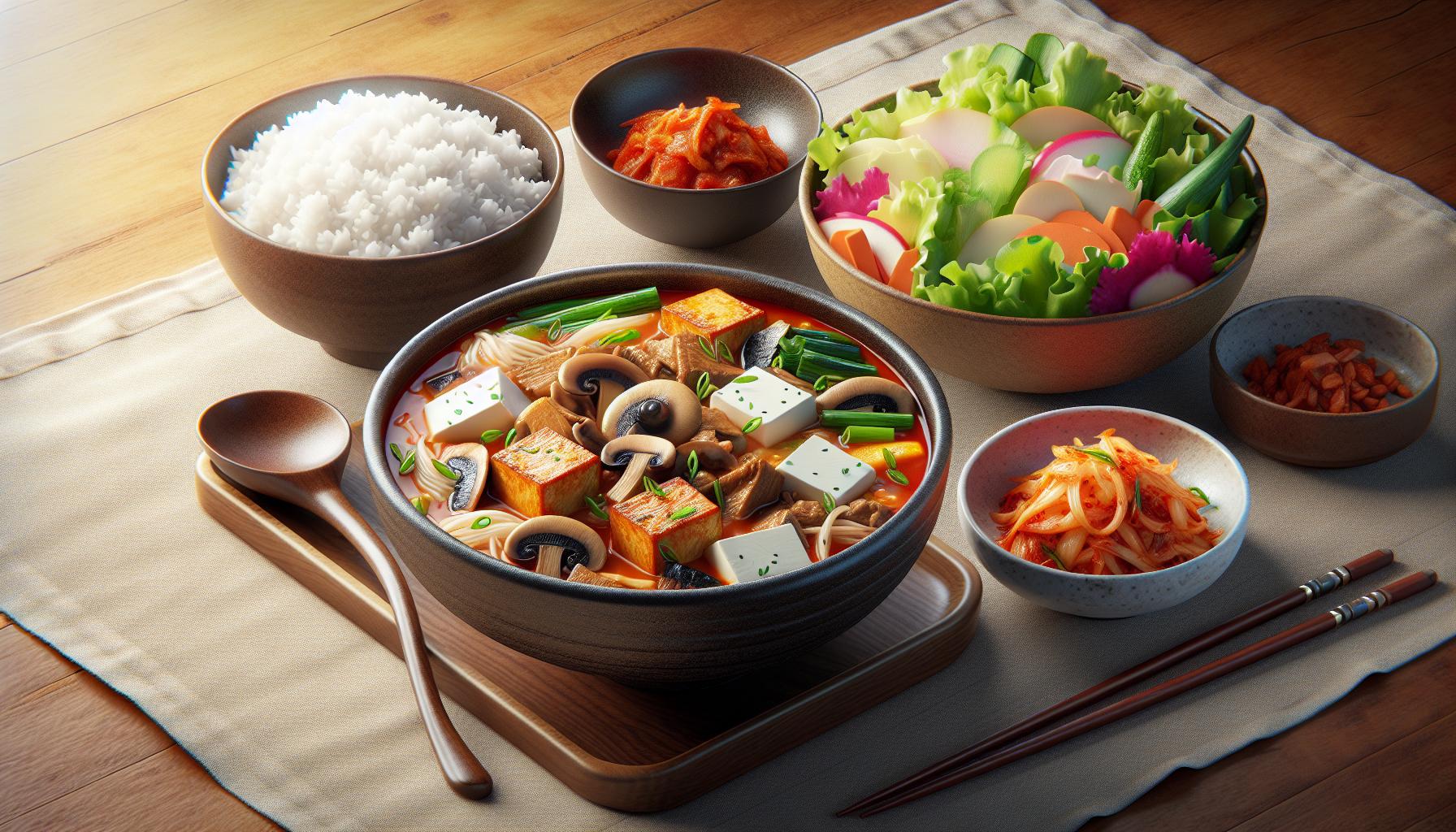Gather the Ingredients
Building the flavor of kimchi jjigae starts with your ingredients. Here’s a list of what you’ll need. Be picky – the better the quality, the more delish your stew.
- 2 cups ripe kimchi: Yes, the star of the show. Ripe provides a more complex and deeper flavor. If needed, younger kimchi will suffice.
- 200 grams pork belly: Pork belly gives an unparalleled rich depth. If not a fan, chicken thighs are a good substitute.
- 1 onion: The sweetness helps balance out the stew.
- 2 scallions: Integrate more freshness and kick.
- 1 teaspoon of chili paste (gochujang): Need heat? This is it.
- 1 teaspoon of minced garlic: Amplifies the savoriness quite a notch.
- 1 tablespoon vegetable oil: Helps in browning your pork.
- 4 cups of water: The base for your stew. You might as well use chicken or beef broth for more richness.
| Ingredients | Quantity |
|---|---|
| Ripe kimchi | 2 cups |
| Pork belly | 200 grams |
| Onion | 1 |
| Scallions | 2 |
| Chili paste (gochujang) | 1 teaspoon |
| Minced garlic | 1 teaspoon |
| Vegetable oil | 1 tablespoon |
| Water | 4 cups |
Arming yourself with the right ingredients takes you halfway in achieving the most delightful kimchi jjigae. But it’s not all. Stay tuned for the next section on preparation and cooking methods. It’ll guide you how to combine these ingredients, how long to cook, and what to look out for. You’ll be serving up a comforting bowl of kimchi jjigae before you know it!
And for those nutrition buffs out there, let your worries go. Kimchi jjigae is not just rich in flavor, but also in essential nutrients. With vitamins A and C from kimchi and protein from the pork belly – you’ve got yourself a hearty, wholesome meal. Just remember, indulge in moderation.
Prepare the Kimchi

Gearing up to prepare? Excellent! Now let’s clarify a few things.
Firstly, you’ll need about 2 cups of ripe kimchi. The trick here is to choose ripe kimchi. Its unique, deep, and mature flavor guarantees your stew gets that desirable and distinct taste. Another perk to ripe kimchi? It’s packed with wholesome nutrients including vitamins A and C. Keep in mind it’s this aged delicacy that truly sets your dish apart.
Your next move? Slice up your kimchi folks! Sizes will vary but half an inch to an inch should do the trick. Remember, keep it chunky to maintain the crunch and texture in your stew.
Here’s an insider tip: don’t toss the kimchi juice. Yup! You heard that right. This wonder-juice is loaded with probiotics and brings an extra kick of flavor to your jjigae. So, while prepping your kimchi, save at least 3 tablespoons of this precious red elixir.
Thinking about a unique twist? How about swapping some of your kimchi for a few pieces of radish kimchi? Also known as kkakdugi, this underrated gem packs a delicious crunch. Plus, it adds a whole other dimension to your jjigae. Note though, you’ll want to handle it just like your cabbage kimchi, saving that delightful kkakdugi juice too.
Lastly, remember details are crucial in authentic Korean cooking. So, take your time with your kimchi. It’s the star player here, right? Treat it with the respect it deserves.
With your prepared kimchi ready, you’re set for the next phase of cooking your homemade kimchi jjigae. Let’s assemble the rest of the ingredients and get that pot bubbling, shall we?
Cook the Pork and Kimchi

First off, it’s time to get your hands on the stove. Grab a medium-sized pot and place it on the heat. When it’s hot enough, drizzle in a tablespoon of sesame oil and let it coat the bottom of the pot. Add in around 200 grams of pork belly, cut into bite-sized pieces. Your patience pays off here, don’t rush this step. Cook the pork belly on medium heat until it’s browned and crispy. A golden brown crust promises a depth of flavor that’s unbeatable.
While the pork is cooking, let’s move on to the kimchi. Remember those chunky slices of ripe kimchi you prepared before? It’s their time to shine. Tip them into the pot and give everything a good stir. Don’t be afraid to let the kimchi fry a bit. This process caramelizes the sugars in your kimchi, enhancing the overall flavor profile of your kimchi jjigae.
But there’s more! To balance out the robust flavors of the pork and kimchi, you need contrast. So dig into your pantry, and find about 50 grams of tofu. Slice the tofu into thin pieces and add them to the pot. The soft, creamy texture of tofu works wonders against the umami-rich backdrop of the jjigae and adds a lovely dimension to it.
Look again into your ingredients. If you want a little extra kick, consider adding in kimchi radish. Known as kkakdugi in Korean, this crunchy delight gives a sweet, refreshing bite that complements the hearty stew.
While following this step, remember to regularly stir the pot. It encourages even cooking and reduces the risk of any ingredients getting burnt. Besides, it’s a great opportunity to fine-tune the flavors. You can add a pinch more of salt, a dash more of chili, or anything else your palate desires.
| Ingredient | Calories | Protein | Fat | Carbs |
|---|---|---|---|---|
| Pork belly | 518 | 22g | 53g | 0g |
| Kimchi | 15 | 1g | 0g | 3g |
| Tofu | 144 | 16g | 8g | 2g |
Add the Broth and Simmer

Now that your pork belly is beautifully browned and your kimchi has caramelized to perfection, it’s time to add the broth and let the dish simmer. Now, if you’re wondering why we’re doing this, it’s simple. Simmering allows the ingredients to absorb and mingle with the liquid, further intensifying the flavor of your kimchi jjigae.
In this step, you’ll require about 4 cups of broth. How your broth is prepared can significantly dictate the final taste of your dish. You can use a rich pork broth if you want a more robust flavor. Alternatively, a vegetable broth, chicken broth, or dashi for a lighter, nuanced taste could be your pick. Now, if you’re feeling adventurous, try a seafood broth. It adds a unique twist to the traditional stew and gives it an extra kick.
Pour the broth into your pot, with its volume depending on your preference for consistency. Adjust the broth based on whether you want a thicker or soupier stew.
Once you’ve added the broth, lower your heat and let your stew simmer. This is your chance to let the flavors meld together. Simmer your stew uncovered for around 15 minutes. Remember, you need to stir regularly, ensuring every inch of your stew gets the same taste-bud tantalizing treatment.
Something to note, don’t rush this simmering phase. It is essential to the overall flavor development of the kimchi jjigae. Consider it the crescendo of this comfort-food symphony.
During the simmering process, do sample the stew. Like a true culinary maestro, make any flavor adjustments you see fit. Feel free to add more broth if it’s too spicy, salt if it’s too bland, or a pinch of sugar to balance out the tanginess.
Why not make this simmering downtime, a nutritional knowledge-up time? Find below the table showing the nutritional info of your homemade Kimchi jjigae:
| Ingredient | Calories | Protein | Carbs | Fat |
|---|---|---|---|---|
| Pork Belly | 120 | 10g | 0g | 13g |
| Kimchi | 15 | 1g | 2g | 0g |
| Tofu | 70 | 8g | 2g | 3.5g |
Serve and Enjoy!

By now, your kitchen is probably filled with the rich, tantalizing aroma of kimchi jjigae. It’s time to serve this heartwarming stew.
Pour generous portions into bowls, taking care to include pieces of pork belly, tofu, kimchi, and mushrooms. Don’t forget to ladle plenty of the savory, spicy broth – it’s the highlight of the dish. On the side, offer bowls of steamed white rice; it’s a traditional accompaniment and complements the flavors of the jjigae.
Switch it up by using brown rice or quinoa instead of white rice for a fiber-intense side dish. They pair excellently with the rich flavors of the jjigae and add a fun, unique twist to your meal.
Nutritionists often point out that foods with varying textures and tastes in one setting stimulate the palate and promote a satisfying dining experience. In this context, serving your jjigae with crisp, fresh salad could be a delightful contrast.
Now let’s talk about your meal’s nutritional composition.
| Ingredient | Calories | Carbs | Protein | Fat |
|---|---|---|---|---|
| Pork belly | 776 | 0 | 17 | 81 |
| Kimchi | 15 | 2 | 1 | 0 |
| Tofu | 144 | 4 | 16 | 8 |
| Rice | 205 | 45 | 4 | 0 |
Keep in mind, the serving sizes and the number of servings can manipulate these numbers.
When you’re serving the dish, remember that the versatility of kimchi jjigae is truly its beauty. As we’ve mentioned before, you’re not restricted to rigid ingredient lists – feel free to make it your own! Maybe you prefer a seafood variation or perhaps a vegan one. The key is to take that boiling pot of jjigae and make it a reflection of your taste. Enjoy the process of personalizing your homemade kimchi jjigae and savor every spoonful of this spectacular Korean comfort food.
Conclusion
So, you’ve got the scoop on how to whip up a homemade kimchi jjigae that’s sure to impress. Remember, pork belly, tofu, kimchi, and mushrooms are your go-to ingredients. Don’t forget to serve it up with rice, or mix it up with brown rice or quinoa. The perfect complement? A fresh salad to add a different texture and taste. And the beauty of this dish? It’s all about customization. Whether you’re a seafood lover or you’re all about that vegan life, there’s a kimchi jjigae variation that’s just right for you. So, get creative and make this savory stew your own. After all, it’s not just about the taste, it’s about the experience. Now, go on and get cooking!

